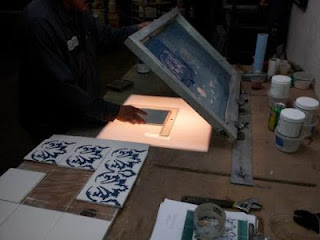I always hate to disappoint a customer; but, I also try to provide a realistic delivery window. Handmade products require time and often don't work for projects that are on a tight schedule. If it can't be done, c'est la vie; but, let's look at the options. Avente works closely with its tile artisans and sometimes, we can beat the standard delivery time or find ways to improve delivery with expedited freight or shipping. I told Tom that we might be able to make the tiles and still meet his deadline. Of course, the artisan agreed and the tiles arrived in time for the show. Tom was kind enough to share a few photos of the tile installation and their exhibit space. Here are the results!
Our Leaf Imprint tiles are popular kitchen backsplash accents; but, I think this is the first time they have been used as part of a trade show set. I've been to a few trade shows in my day and the exhibit show-stoppers are usually going for "wow" or "big." The Ground Crafter team created the most tranquil, peaceful exhibit space I've seen. I noticed they even included benches and cushions. Smart decision. Not only does it make the space more cozy, but also adds visual value. Seating at any trade show is hard to find. My congratulations for a nice job, Tom! I'm glad we could help with the tiles.
The tile's stony matte finish accents natural stone beautifully and you can see that Tom took the same cue. In this installation, the Leaf Imprint tiles take center stage to a backdrop of flagstone and peaceful, flowing water. The look is further enhanced with the use of stained wood frames around the tiles, which really makes them pop. A similar "picture frame" effect can be achieved with ceramic tile molding in wood tones. The variation found in each hand-painted tile mimics nature in that no two hand-colored leaves are exactly the same.
Large Pressed Leaf Tiles
Pressed with real leaves, these decorative hand-painted 8"x8" tiles include a Maple Leaf, Ash Leaf and Ginkgo Leaf design. Tom chose one of each design in the 8"x8" format to create a triptych that has perfect balance.Thanks to The Ground Crafter
Thanks again to Tom and his crew for sharing sharing how they used our tiles in a unique installation. The Ground Crafter is an expert team of designers, landscapers, carpenters, masons and gardeners. They have skills for advanced landscaping projects, including both code-compliant electrical and plumbing work. The company's mission is to create healthy, beautiful environments that enhance the quality of life. If you are in the Milwaukee, Wisconsin area and in need of landscape design, stop by and see Tom and the team. They are located at 1409 W. Wanda Ave.Are you looking for further inspiration with hand-painted decorative tiles? Then visit our Ceramic Tile Design Ideas portfolio for detailed installation photos and concepts.
Ceramic Tile Projects from Avente Customers
If you enjoyed this article, then you might enjoy these Tile Talk articles that show how Avente customer's have used our hand-painted tiles in their homes. Our customers have also used tiles to add style and a personal touch to their home. Here are a few posts devoted to tile floor accents and kitchen backsplashes using our hand-painted ceramic tiles.- Leaf Imprint Tile Backsplash from a Reader
- Leaf Imprint Tiles Make the Kitchen Backsplash
- Portuguese Tiles for a Residential Kitchen Retrofit
NOTE: Images of the above trade show water feature are courtesy of Tom Auer, owner of the landscape architecture firm, The Ground Crafter.















